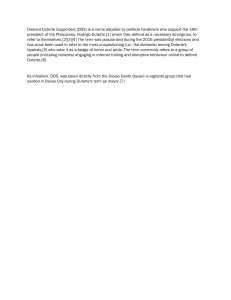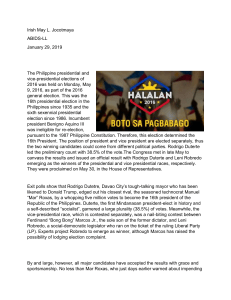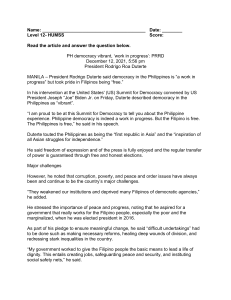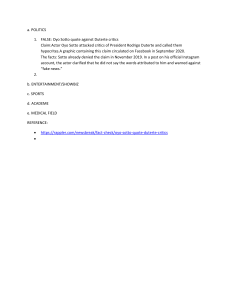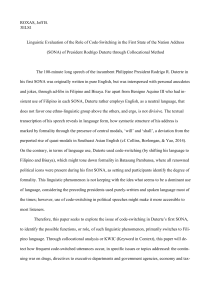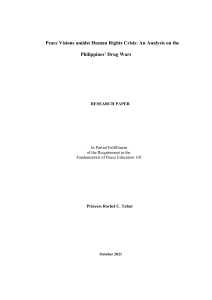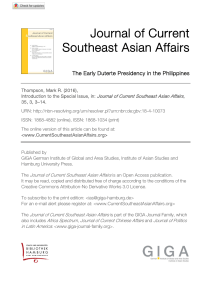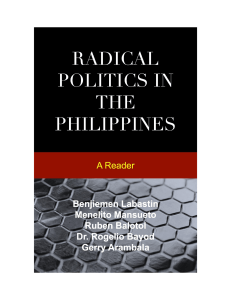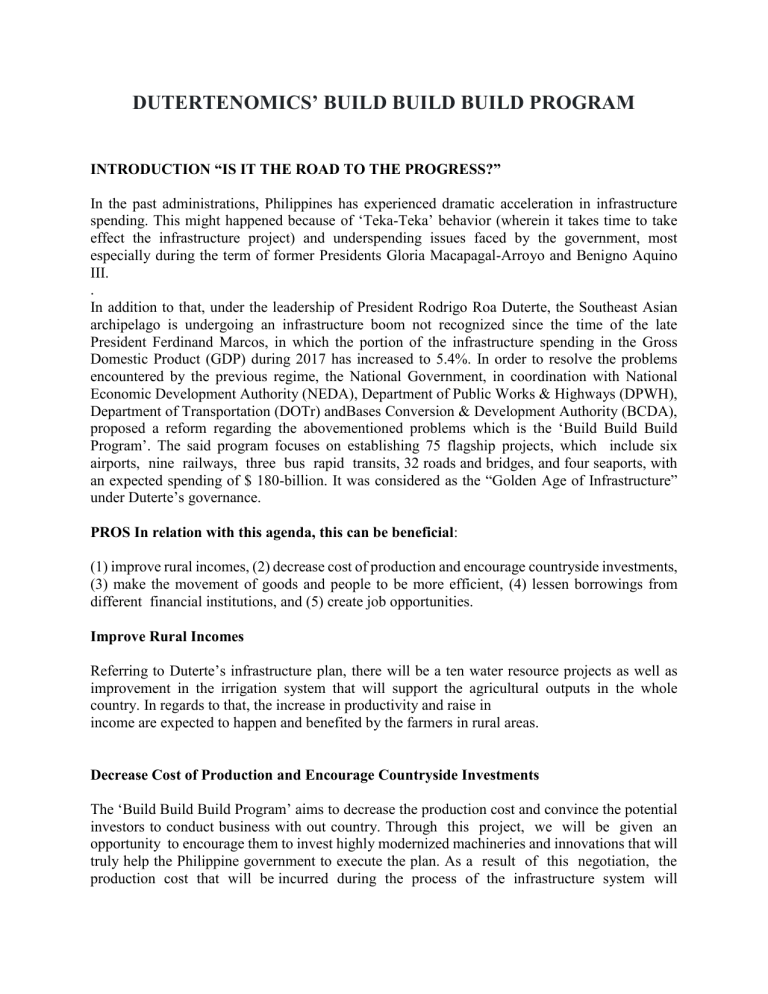
DUTERTENOMICS’ BUILD BUILD BUILD PROGRAM INTRODUCTION “IS IT THE ROAD TO THE PROGRESS?” In the past administrations, Philippines has experienced dramatic acceleration in infrastructure spending. This might happened because of ‘Teka-Teka’ behavior (wherein it takes time to take effect the infrastructure project) and underspending issues faced by the government, most especially during the term of former Presidents Gloria Macapagal-Arroyo and Benigno Aquino III. . In addition to that, under the leadership of President Rodrigo Roa Duterte, the Southeast Asian archipelago is undergoing an infrastructure boom not recognized since the time of the late President Ferdinand Marcos, in which the portion of the infrastructure spending in the Gross Domestic Product (GDP) during 2017 has increased to 5.4%. In order to resolve the problems encountered by the previous regime, the National Government, in coordination with National Economic Development Authority (NEDA), Department of Public Works & Highways (DPWH), Department of Transportation (DOTr) andBases Conversion & Development Authority (BCDA), proposed a reform regarding the abovementioned problems which is the ‘Build Build Build Program’. The said program focuses on establishing 75 flagship projects, which include six airports, nine railways, three bus rapid transits, 32 roads and bridges, and four seaports, with an expected spending of $ 180-billion. It was considered as the “Golden Age of Infrastructure” under Duterte’s governance. PROS In relation with this agenda, this can be beneficial: (1) improve rural incomes, (2) decrease cost of production and encourage countryside investments, (3) make the movement of goods and people to be more efficient, (4) lessen borrowings from different financial institutions, and (5) create job opportunities. Improve Rural Incomes Referring to Duterte’s infrastructure plan, there will be a ten water resource projects as well as improvement in the irrigation system that will support the agricultural outputs in the whole country. In regards to that, the increase in productivity and raise in income are expected to happen and benefited by the farmers in rural areas. Decrease Cost of Production and Encourage Countryside Investments The ‘Build Build Build Program’ aims to decrease the production cost and convince the potential investors to conduct business with out country. Through this project, we will be given an opportunity to encourage them to invest highly modernized machineries and innovations that will truly help the Philippine government to execute the plan. As a result of this negotiation, the production cost that will be incurred during the process of the infrastructure system will be diminished since the properties supplied by these investors will play a significant role in achieving our goal. Make the Movement of Goods and People to be More Efficient Under this program, the newly-built roads and bridges connecting from rural to urban areas will make the transfer of outputs convenient and efficient. Furthermore, the transactions between firms and households will be conducive. Lessen Borrowings from Different Financial Institutions Under the new tax reform package of the government, so-called Tax Reform for Acceleration and Inclusion or TRAIN Law, the taxes received by the government would be generate a lot of revenue to help finance the aforementioned program and improve the capacity of the government to reduce borrowings for the development of economy. Create Job Opportunities Lowering unemployment rate is one of the targeted goals of the administration. Thus, ‘Build Build Build Program’ offers various job opportunities to cure the aforementioned issue. Several construction companies will be needed a lot of workers to make the project feasible. This project will be a stepping stone to the progress of the economy, as well as in increase of income of every individuals. CONS On the other hand, the said program has its negative impacts, not only on the individual aspects, but also in the economy as a whole. The disadvantages emphasize (1) economic risks(i.e., inflation), (2) interest rate issues, (3) contractor risk, and (4) unavoidable scenarios that will most likely to happen . Economic Risks The expected production cost from the time the plan was executed will be adjusted to the current prices if the country will experience rising inflation rate. Moreover, this scenario could lead to the rearrangement of country’s priorities. It actually means that the attention of the government will be moved to other aspects like education, national defense and interest payments. Interest Rate Issues As the government has insufficient fund in constructing the projects, they will tend to borrow long-term investments from the foreign countries that will be a big part of the national budget, hence, the latter will impose higher interest rates as a major consequence in the near future. Contractor Risk The wrong choiceof contracting parties will result in a failure of performing the original objectives and incur higher cost. Corruption may be one of the cause of the poor implementation of projects because of its contractor failure. This could also happen whether the source of budget is the national budget itself or some private contracts (public-private partnership). Unavoidable Scenarios that will Most Likely to Happen Failure to identify the real problem during the recognition stage will make the program less effective. Like for example, there’s an instance that the roads which are well-constructed will be destroyed as part of the infrastructure projects in the locality. The program must enter into legislation wherein the contract will be executed from the Congress and Senate to be approved by the President. Despite of this fact, the President Duterte’s action plan to answer the case of economic development has a negative implication as itdid not follow the due process. Reaction: After gathering all the facts regarding the positive and negative impacts of ‘Build Build Build Program’, it is favorable to implement this Pres. Duterte’s infrastructure plan. The rapid increase in the country’s Gross Domestic Product (GDP), the avoidance of underspending as well as in infrastructure projects and the high demand for employment are the expected outcomes of the said project once it will be implemented. Overall, the major concern of the administration focuses on the Philippines’ economic development. Every country’s GDP using expenditure approach is computed by adding the household consumption, investments, government expenditures and net exports . The idea of so-called ‘golden age of infrastructure’ is to enrich these components, most especially investments and government expenditures, because as observed in the administration of Pres. Benigno Aquino III in his first year of presidency (2010), the percentage of infrastructure spending as indicated in the GDP. The objective of the recent administration is to drive up the GDP before his term ceased. During the last two years of Pres. Aquino’s term, the projects for that particular years were not been performed. As pertaining to the essence of the scheme, this aftermath must be prevented and the proposed blueprint of the government will not remain “drawing” until the end of Duterte’s leadership. The Philippines suffers from unemployment and poverty because of poor infrastructure. Considering the intention of aforesaid proposition, there will be a high potentiality that the unemployed Filipino citizens will be given a chance to grab job opportunities which eventually result to GDP increase in household consumption category and will lead to a major decrease in the current unemployment rate.
